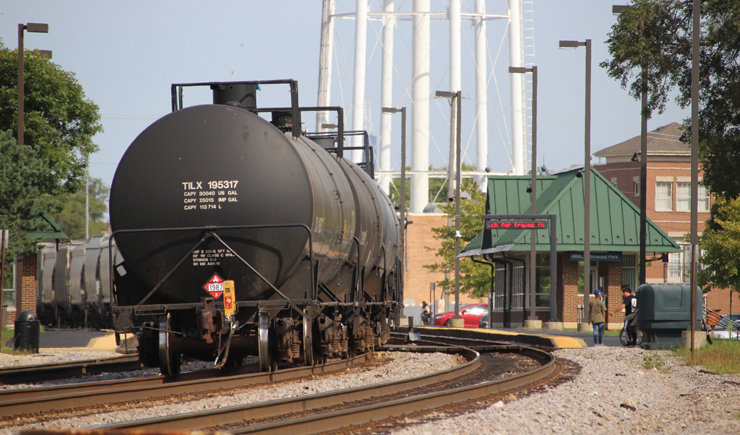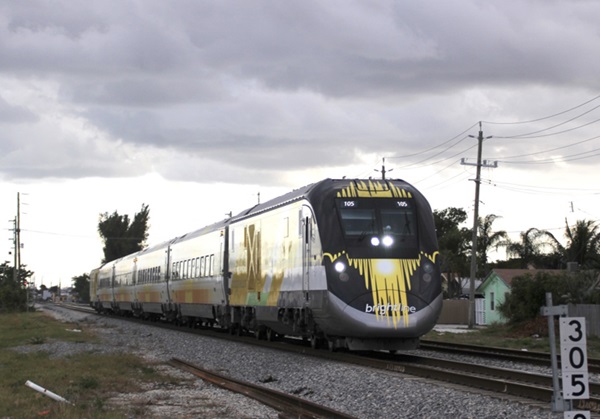WASHINGTON — The federal government is moving forward with a controversial plan to allow liquified natural gas to move by rail, publishing a notice of proposed rulemaking on Friday.
The proposal by the U.S. Department of Transportation’s Pipeline and Hazardous Materials Safety Administration and the Federal Railroad Administration would allow LNG to move by rail in DOT-113 tank cars. Liquified natural gas can currently move by truck, or by rail only in a portable tank, with approval by the FRA.
A press release from the DOT on Friday noted the DOT-113 cars are designed for transportation of refrigerated liquified gases, and their use is allowed for the transportation of other flammable materials. “This design specification may be similarly suitable for the transportation of refrigerated liquid methane,” the release says.
The proposal, a response to an April 2019 executive order by President Donald Trump, drew immediate criticism from Rep. Peter DeFazio (D-Ore.), chairman of the House Committee on Transportation and Infrastructure.
The executive order directed the Secretary of Transportation to finalize a rule within 13 months that would “treat LNG the same as other cryogenic liquids and permit LNG to be transported in approved rail cars.”
In the release announcing the proposed rule, Skip Elliott, administrator of the pipeline and hazards materials administration, said, “Safety is the number one priority of PHMSA, and we understand the importance and will make it a top priority to evaluate all public comments and concerns raised throughout the rulemaking process,” said PHMSA Administrator Skip Elliott. “This major rule will establish a safe, reliable, and durable mode of transportation for LNG, while substantially increasing economic benefits and our nation’s energy competitiveness in the global market.”
FRA Administrator Ron Batory said the rulemaking proposal “is consistent with our systemic approach to accident prevention, mitigation, and emergency response preparedness.”
In September, DeFazio and Rep. Tom Malinowski (D-N.J.) introduced legislation, the “Protecting Communites from Liquefied Natural Gas Trains Act,” which would require the FRA administrator to “conduct an evaluation of the safety, security and environmental risks of transporting liquefied natural gas by rail.” It would require physical testing of DOT-113 cars to ensure the cars are able to withstand accidents and “prevent or mitigate” the release of LNG.
On Friday, DeFazio issued a statement saying the authorization to move hazardous materials by rail “should be a careful and deliberative process, supported by science and evidence, with adequate protections in place for the communities where this stuff is travelling. It is not something to be done with the stroke of a pen. The results of his order could be catastrophic.
“The Trump administration’s plan to put a dangerous liquid in old tank cars without sufficient testing, analysis, or reviews poses major risks to the health and safety of communities across the nation. If one tank car had even one minor puncture, the deadly results could be felt for miles.”
Publication of the rule on Friday begins a 60-day period for public comment on the proposal.















The opportunity to move LNG by rail would allow has to be moved out of regional pipeline networks. If it can be done safely it would allow the growth of LNG markets.
One of the issues about natural gas is it needs a lot less processing then gasoline or diesel, and would cut out a large amount of the refinery business.
We’ve had LNG truck accidents here in Alaska. We’ve also had a disproportionately large number of fuel truck accidents and rollovers and spills. A couple have had fatalities. All have cost environmental and economic damages. There are frequent, if not daily, trucks bringing LNG from Cook Inlet (Anchorage area) to Fairbanks. This should be on the parallel Alaska Railroad.
A quick Google search brought up this info:
The historical reality is that LNG has the best safety record of all common fuel types and is completely non-toxic. Of course natural gas vapors are flammable and present safety hazards that must be managed, but these hazards are substantially less than for gasoline, diesel and other liquid fuels.
When LNG spills on the ground or water it vaporizes quickly and leaves behind no residues. LNG spills on water do not harm aquatic life or damage waterways in any way. As LNG vaporizes, the vapor cloud can ignite if there is a source of ignition, but otherwise LNG dissipates completely.
Exactly greg but Washington has to get in the way.
Seems it would be MUCH safer than Truck Tankers…………
I’ll say this and yes this is tied to politics. The democrats are trying to stop LNG by rail.. Yet every other country around the world has been hauling LNG for decades by rail. Russia especially.. Once again government making our country un-competitive again… I’m glad trump made this an executive order..
To add to what Richard said, LNG is lighter than air so when released it vaporizes and floats up. LPG on the other hand is heavy than air and when released will remain close to the ground and thus has a greater chance of reaching a contact point of ignition. For example in the 1970s an LPG car was breached in an over speed impact in the yard in Decatur, IL. The LPG spread through the yard until it reached a heater in a building and then exploded. If it had been LNG an explosion might not have happened. Safety aspects of hauling LNG need to been reviewed but I can’t see not hauling it under the same restrictions as LPG.
I have no problem with moving LNG in rail cars. There are some crude oil cars, by virtue of the mix of elements in the crude oil are, in fact more dangerous than LNG or ordinary natural gas.
So they want to let the railroads haul LNG (Liquefied Natural Gas) Can anyone tell me why that would be worse than hauling LPG (liquefied petroleum gas) acid’s, or Chlorine? It all is bad stuff if there’s a derailment. But I would rather have it on rails than on the interstate. I’ve seen a few eighteen wheeler gasoline tankers go up in flames. Not nice! An right now all of our trash trucks are powered by it so it’t right in front of my house twice a week.
I wonder what the railroads take on this is. I suspect for the right money they’ll haul it. But this day in time they might not won’t the responsibility or the extra business.